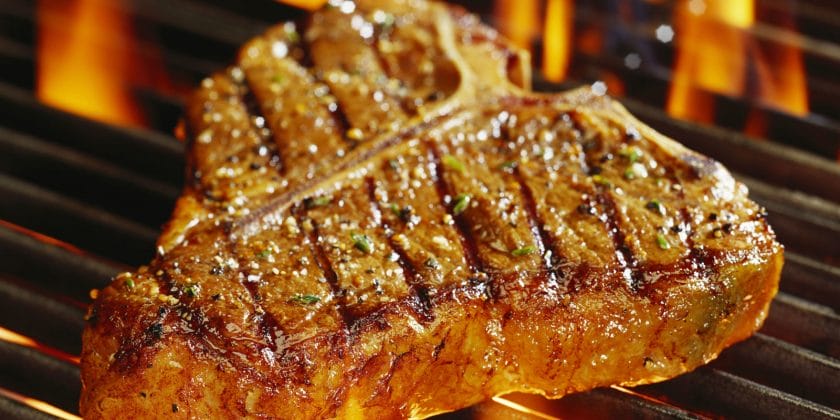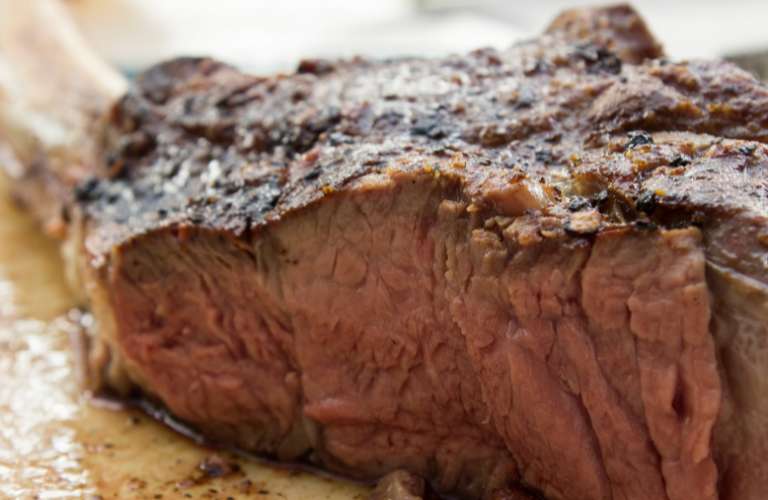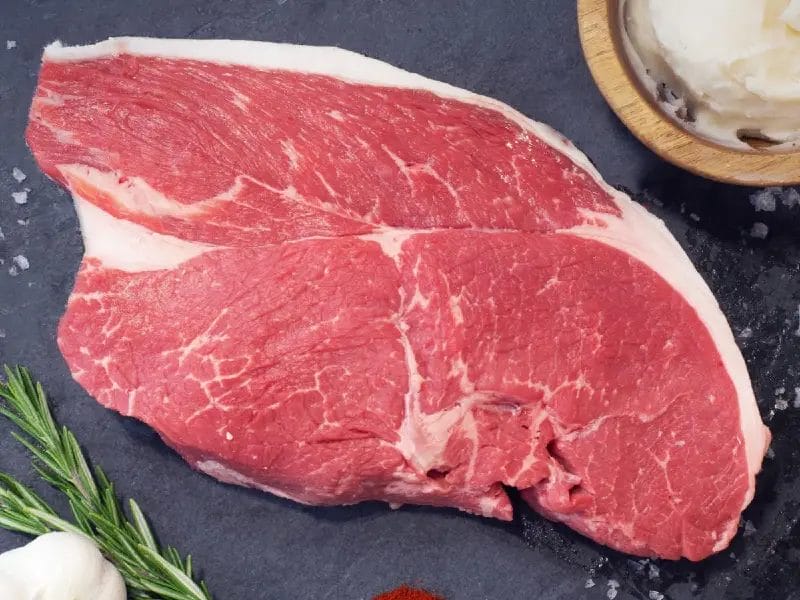Steak, a beloved dish enjoyed by meat lovers worldwide, has a history dating back centuries. While its exact origin may be difficult to pinpoint, steak as we know it today is commonly associated with Western cuisine.
This flavorful and succulent cut of meat has become a staple in many cultures, with various cooking methods and seasonings used to enhance its taste.
From the traditional American steakhouse to the trendy grill joints, steak continues to satisfy our carnivorous cravings with its rich flavor and tender texture.

The History of Steak: Origins and Evolution
Steak, a beloved culinary delight enjoyed by meat lovers around the world, has a rich history that traces back centuries. This mouthwatering dish has evolved over time, encompassing various cooking techniques, cuts of meat, and cultural influences.
In this section, we delve into the origins and evolution of steak, exploring its journey from humble beginnings to becoming a global sensation.
The Beginnings of Steak
The concept of steak can be traced back to ancient times, where early civilizations discovered the art of cooking meat over an open flame.
The consumption of grilled or roasted meat has been a fundamental part of human culinary practices since the discovery of fire. However, it wasn’t until later that the specific term “steak” emerged.
The word “steak” has its roots in the Old Norse word “steik,” which means “to roast on a spit.” This method of cooking involved skewering meat on a long rod and roasting it over an open fire. Over time, this technique evolved, with various cultures incorporating their own unique flavors and cooking methods.
The Evolution of Steak
As civilizations advanced, so did their culinary techniques. From the ancient Greeks and Romans to the medieval Europeans, each culture contributed to the evolution of steak as we know it today.
In ancient Greece and Rome, steak-like dishes were prepared by marinating meat in wine or vinegar and then grilling or broiling it. These early methods helped to tenderize the meat and enhance its flavor.
The Romans, in particular, were known for their love of beef, and steak-like cuts were a popular choice among the upper class.
During the Middle Ages, European cuisine saw the rise of the steak as a staple dish. Beef became more readily available, and the concept of aging meat for added tenderness was introduced. The practice of searing meat over high heat to seal in the juices also gained popularity.
The Influence of the New World
The discovery of the New World in the late 15th century brought about significant changes in the world of steak. The introduction of cattle to the Americas by Spanish explorers led to the development of new cuts and cooking techniques.
One of the most significant contributions to the steak world was made by North American ranchers during the 19th century.
They introduced the concept of dry aging, where meat is hung in a controlled environment to enhance its tenderness and flavor. This technique is still widely practiced today, and it has become synonymous with quality steaks.
Additionally, America’s thriving cattle industry gave rise to a variety of steak cuts, including the iconic T-bone, porterhouse, and ribeye. These cuts became popular choices in steakhouses and backyard grills across the country.

Steak Today: Global Delicacy
Today, steak has achieved global fame and is enjoyed in various forms and cooking styles across different cultures. Each region has its own unique take on steak, showcasing the diversity and versatility of this beloved dish.
In Argentina, the traditional asado (barbecue) is a cultural institution, where beef is grilled over an open flame to perfection. In Japan, the art of Kobe beef has elevated steak to new heights, with its buttery texture and marbling.
Steakhouses have become popular establishments worldwide, offering a wide range of cuts and preparation methods to cater to different tastes. From the classic American-style steakhouse to the modern fusion restaurants, the options are endless.
Ancient Origins of Steak: Tracing its Roots
Steak, a juicy and succulent cut of meat that is enjoyed by many around the world, has a rich culinary history that dates back centuries. In this section, we will explore the ancient origins of steak and trace its roots to civilizations that recognized the value and deliciousness of this meaty delight.
The Beginnings of Steak
The concept of steak can be traced back to ancient times, where early civilizations discovered the art of cooking meat over an open flame.
The practice of grilling or searing meat is believed to have originated in ancient Egypt and Mesopotamia, where the availability of fire and the abundance of livestock allowed for the development of this cooking technique.
Ancient Roman Cuisine
The ancient Romans were known for their extravagant feasts and indulgent culinary traditions. They played a significant role in the evolution of steak as they were one of the first cultures to appreciate the tenderness and flavor that came from cooking meat to perfection.
The Romans commonly consumed beef, and it was prepared in various ways, including roasting, grilling, and braising.
The Medieval Influence
During the Middle Ages, steak continued to be a popular choice among the nobility. The English, in particular, developed a fondness for beef, and various cuts of steak were served at elaborate banquets. Steak was often seasoned with herbs and spices, enhancing the flavors and making it a sought-after delicacy.
The Rise of Steakhouses
In the 19th century, the development of railroads and the expansion of cities led to the rise of steakhouses.
These establishments became known for their expertise in cooking and serving delicious cuts of steak, attracting a wide range of patrons. Steakhouses quickly became social hubs where people could gather and enjoy a hearty meal.
Modern Steak Culture
Fast forward to the present day, and steak remains a beloved dish enjoyed by people of all backgrounds. From the classic American steakhouse to international cuisines that put their unique spin on this classic dish, steak continues to be a staple on menus worldwide.
The Cultural Significance of Steak: From Past to Present
Steak has been a centerpiece of culinary culture for centuries, with its rich flavors and succulent textures captivating food enthusiasts around the world. This article explores the cultural significance of steak, tracing its journey from the past to the present, and shedding light on its enduring popularity.
The Historical Roots of Steak
Steak’s history can be traced back to ancient times when humans discovered the art of cooking meat over an open flame. In ancient civilizations, such as ancient Rome and Greece, steak was a symbol of opulence and status.
It was reserved for the elite and served as a centerpiece during grand feasts and banquets. The tradition of grilling and savoring juicy cuts of beef has deep roots that have transcended generations.
Regional Variations and Traditions
As steak gained popularity across different regions, unique variations and traditions emerged. In Argentina, for example, steak became an integral part of the cultural identity, with the famous Asado becoming a beloved national dish.
The Argentinian way of grilling beef over an open flame, known as the parrilla, has become iconic and is celebrated worldwide.
In the United States, steak has a long-standing association with the Wild West and the cowboy culture. The image of cowboys sitting around a campfire, grilling steaks on an iron skillet, has become deeply ingrained in American folklore.
The American steakhouse tradition also emerged, with renowned establishments serving prime cuts of beef to discerning patrons.
Steak in Modern Times
Steak continues to hold a prominent place in modern culinary culture. It has evolved beyond being a symbol of extravagance and has become more accessible to people from all walks of life. From high-end steakhouses to casual grill restaurants, steak is widely enjoyed and celebrated.
Additionally, the way steak is prepared and served has undergone a transformation.
Chefs and home cooks alike have experimented with various cooking techniques, seasonings, and marinades to bring out the best flavors in steak. From perfectly seared steaks to mouthwatering steak sandwiches, there are countless ways to savor this beloved dish.
Health Considerations and Ethical Choices
While steak remains a favorite indulgence for many, health considerations and ethical choices have also come into play in recent years. The impact of red meat consumption on health and the environment has sparked conversations about sustainable alternatives and the importance of moderation.
As a result, plant-based alternatives that replicate the taste and texture of steak have gained popularity. These alternatives provide a guilt-free option for those looking to reduce their meat consumption while still enjoying the flavors and experience of a classic steak.
Exploring the Origins of Steak: A Culinary Journey
Steak, a succulent and flavorful cut of meat, holds a special place in the culinary world. Whether you prefer it rare, medium, or well-done, steak has been enjoyed by people around the globe for centuries.
But have you ever wondered where this delicious dish originated? Join us on a culinary journey as we delve into the fascinating history of steak.
1. The Ancient Roots
The concept of cooking meat over an open flame dates back to ancient times. In fact, our ancestors discovered the art of grilling long before the invention of stoves and ovens.
Cave paintings and archaeological evidence reveal that early humans hunted game and cooked it over a fire, laying the foundation for what would eventually become steak.
One of the earliest references to steak can be traced back to the ancient Egyptians. They would slice meat into thin strips and grill them over an open fire, a method known as “sekhbet.”
These strips of meat were then seasoned with herbs and spices, creating a delectable meal enjoyed by the pharaohs and their subjects.
2. The Evolution of Steak
As civilizations advanced, so did the techniques used to prepare steak. In ancient Rome, the wealthy indulged in a dish called “isicia omentata,” which consisted of ground meat mixed with bread, wine-soaked mushrooms, and various seasonings.
This precursor to modern-day steak showcased the Romans’ culinary prowess.
During the Middle Ages, beef became a sought-after delicacy among European nobility. Kings and queens would feast on roasted beef, often served with rich sauces and accompanied by lavish banquets. However, it wasn’t until the 17th century that the term “steak” emerged.
One popular theory suggests that the word “steak” originated from the Old Norse word “steik” or the Middle English word “steik.” Both terms referred to a thick slice of meat cooked by grilling or broiling.
3. The Rise of Modern Steak
Fast forward to the 19th century, and we find ourselves in the heart of the Industrial Revolution. As transportation and refrigeration improved, the availability of beef increased, making steak a more accessible and popular dish.
The invention of the modern steakhouse allowed people from all walks of life to indulge in this mouthwatering delight.
Throughout history, different countries have developed their own unique styles of preparing and seasoning steak. From the juicy T-bones of America to the tender fillets of France, each culture has contributed its own flair to this beloved dish.
4. Steak in the Modern World
Today, steak continues to be a culinary staple enjoyed by meat lovers around the world. As our understanding of meat cuts and cooking techniques has evolved, so has the variety of steak available. From ribeye and sirloin to porterhouse and flank, there is a cut to suit every palate.
Steakhouses have become iconic dining destinations, offering an array of steak options and accompanying sides. Whether you prefer a classic steak frites or a modern twist like a steak salad, there is no shortage of innovative and delicious ways to enjoy this timeless dish.

From Farm to Table: The Story of Steak’s Origin
Steak, a juicy and flavorful cut of meat, has been a favorite dish for meat lovers all around the world. But have you ever wondered where steak comes from and how it makes its way to your plate?
In this section, we will take a journey through the farm-to-table process of steak’s origin, from the rearing of cattle to the delectable steak served at your favorite restaurant.
The Rearing Process: Cattle Farming
It all begins on the vast grassy fields of cattle farms, where ranchers dedicate their time and effort to raising healthy and high-quality cattle. Cattle are usually bred for specific purposes, such as beef production, and are carefully selected based on their genetic traits and breed characteristics.
The rearing process involves providing the cattle with nutritious diets, ample grazing areas, and proper healthcare to ensure their well-being.
Cattle farming practices can vary depending on the region and farming methods.
Some cattle farms follow traditional methods, allowing the cattle to graze freely on open pastures, while others may opt for a more controlled environment, providing shelter and supplementary feed to the cattle. Regardless of the approach, the goal is to raise cattle in a sustainable and humane manner.
Slaughter and Processing: From Ranch to Abattoir
When the cattle reach the desired weight and maturity, they are transported from the farm to an abattoir for slaughter and processing. The transportation process ensures the welfare of the animals, minimizing stress and discomfort.
At the abattoir, highly skilled workers carry out the slaughtering process according to strict regulations and guidelines to ensure both food safety and animal welfare.
After slaughter, the carcasses undergo a meticulous inspection to ensure their quality and suitability for consumption. Then, the beef is processed, which involves various stages such as trimming, cutting, and packaging.
The beef is typically divided into different cuts, including the prized cuts that make up the delectable steaks we enjoy.
Wholesale and Retail: Distributing Steak to Your Local Market
Once the beef is processed, it is packaged and sent to wholesale distributors who supply it to various establishments, such as restaurants, butcher shops, and supermarkets. These distributors play a vital role in ensuring the efficient and timely delivery of the beef to the local market.
Butcheries and supermarkets receive the beef from the distributors and further process it based on customer demands. Skilled butchers carefully handle the beef, expertly cutting it into different steak cuts and ensuring the highest quality standards are met.
The steaks are then displayed in the meat section, ready to be purchased by eager customers.
From the Kitchen to Your Plate: Culinary Delight
Finally, the journey of steak’s origin culminates in the skilled hands of chefs and home cooks who transform the raw steak into a culinary masterpiece. Through various cooking techniques, such as grilling, pan-searing, or broiling, the steak is cooked to perfection, resulting in a tender and flavorful delight.
Whether you prefer a rare, medium, or well-done steak, the final step of the farm-to-table process ensures that the steak is seasoned and prepared according to your liking. It is then served alongside a variety of delectable sides, creating a memorable dining experience.
In Summary
From the expansive cattle farms to your dinner table, steak’s origin is a journey that involves careful rearing, humane slaughtering, expert processing, and skillful culinary preparation. Understanding the farm-to-table process allows us to appreciate not only the deliciousness of steak but also the hard work and dedication of those involved in bringing this savory delight to our plates.

Frequently Asked Questions
1. Where did steak originate?
Steak is believed to have originated in ancient times, with evidence of early humans cooking and eating roasted meat. However, the modern concept of steak can be traced back to the 19th century in Europe and later gained popularity in the United States.
2. How long should I cook a steak?
The cooking time for a steak depends on various factors such as the thickness of the steak, desired doneness, and cooking method. As a general guideline, a 1-inch thick steak cooked on a grill or stovetop should be cooked for about 4-5 minutes per side for medium-rare doneness.
3. How should I season a steak?
Seasoning a steak is a matter of personal preference, but a simple and popular method is to use salt and pepper. Generously season both sides of the steak with salt and freshly ground black pepper before cooking to enhance its natural flavors.
Conclusion:
In conclusion, the origin of steak can be traced back to ancient times. It has a rich history and has evolved over the centuries to become a beloved dish around the world.
From its humble beginnings as a simple method of preserving meat, steak has transcended cultural boundaries and become a culinary staple in many countries.
Whether it’s the juicy and tender cuts of beef in America, the succulent Wagyu beef in Japan, or the flavorful Argentinian steaks, this dish continues to satisfy taste buds and delight carnivores everywhere.
With its irresistible aroma and mouthwatering taste, steak has become a symbol of indulgence and celebration. It has also inspired various cooking techniques and recipes, making it a versatile ingredient that can be enjoyed in different preparations.
Whether it’s a sizzling grill, a hot pan, or a slow-cooker, steak has the power to bring people together and create unforgettable dining experiences.
So, the next time you savor a perfectly cooked steak, take a moment to appreciate its fascinating history and the craftsmanship that goes into creating this timeless culinary masterpiece.

